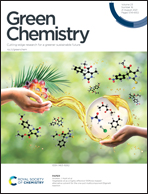Integration of acetic acid catalysis with one-pot protic ionic liquid configuration to achieve high-efficient biorefinery of poplar biomass†
Abstract
Recyclable biocatalysts and high-efficiency lignocellulose deconstruction are the crucial factors for cost-effective conversion of biomass into biofuels and bioproducts. Acetic acid-based catalytic hydrolysis of grassy lignocellulosic biomass presents a promising application because of its effectivity, recyclability, and other environmentally friendly features. However, this treatment is not as effective on woody biomass, such as poplar. One way to improve conversion performance of this process is to integrate it with other effective processes, such as pretreating biomass with protic ionic liquids (PILs) that have been shown to effectively solubilize lignin in reducing the recalcitrance of biomass to enzymatic deconstruction. In this work, an integrated acetic acid based one-pot ethanolamine acetate pretreatment (HAc–[EOA][OAc]) was developed for the efficient depolymerization of poplar polysaccharides. The configuration simultaneously removed ∼88% hemicellulose and selectively extracted up to ∼46% of the lignin from lignocellulosic biomass. HAc–[EOA][OAc] pretreated poplar yielded over 80% enzyme-hydrolyzed glucose that was attributed to an increase in the accessible surface area of cellulose to the hydrolytic enzymes. Analysis of the cellulose crystallinity and thermal decomposition profiles revealed that all pretreated samples have a higher cellulose crystallinity, indicating that amorphous cellulose had been removed during pretreatment. Conductor like screening model for real solvents (COSMO-RS) and Hansen solubility parameters (HSP) were used to provide insights into the mechanism of biomass pretreatment efficacy using both HAc and [EOA][OAc]. We found that a strong hydrogen-bonding and electrostatic misfit interaction between hemicellulose and HAc may explain the higher removal of hemicellulose during HAc pretreatment. Further, the close HSP values and COSMO-RS analysis indicate that [EOA][OAc] is a good lignin solvent, which leads to the higher delignification of biomass. This study demonstrates that the integration of IL with acid pretreatment is a promising strategy for conducting effective pretreatment on woody lignocellulose.



 Please wait while we load your content...
Please wait while we load your content...